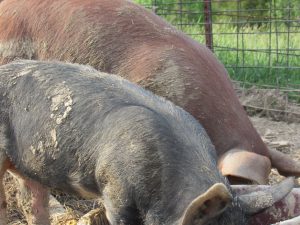It is the kind of drive that restores some of my dwindling supply of faith. On this late spring day, two kids in inner tubes are bobbing in the faster current of the creek that sweeps under the bridge over Possum Trot. It is an unremarkable stream that runs alongside our road, and it never builds up much speed unless in flood. I honk my horn in hello as I pass. Across the way a neighbor is using a skid steer to smooth out a new driveway. He looks up and waves.

Young gilts
The skies are May blue, with deeper shades and depths in the distance where storms linger without threat. I make the left turn onto Ross Road. In a small pasture on the right that stretches back to a low wooded ridge, a large family works together to set out a garden. The man tills while his teenage sons pull sod from the patch. Back a distance from the road, a cluster of women chat in the shade. Perched in lawn chairs next to another stream, they keep a close eye on a passel of youngsters who run shrieking in and out of the water in a game of chase. I honk again and wave.
Around the curve I brake suddenly for a flock of chickens crossing. They belong to a neighbor whose poultry roam at will during daylight hours, as they should on all winding country lanes. That I never see a dead chicken in the road shows that either the poultry are street savvy or at least that area drivers keep a sharp watch. Off to the side of the neighbors’ is a small homemade hoop house. Behind it, in a quarter-acre lot, a distinctive pod of hogs lies beached under the cool shade of overhanging trees.
I glance to the left, where Big Sandy cuts off on an asphalt tributary. A man feeds his horses and another stacks firewood. Ross Road follows a soft curve, framed by a never-run-dry spring to the left and a bulk feed bin to the right. Cresting the hill, I see off behind a well-maintained rancher that the wife of a fellow who has dug several ponds on our farm is taking her rest from mowing the yard. We both wave.
Ross takes a long upward bend to the east just after passing Lynn Road, to the south. I come upon the Burnett family, who periodically buy our feeder pigs. They have recently leveled an old barn (which with the next good gust of wind would probably have fallen on its own), and today some of them are busy preparing the foundation for a replacement. Others are hoeing in an adjacent and embarrassingly tidy garden. Knowing the state of my own garden plot, I am tempted not to honk, but they flip me a quick wave and I reply in kind.
The road narrows as it passes through a wood just before the Brights’ dairy. Upon emerging from the trees, the lane aligns at certain times of the year with both the rising sun and the eastward route of the morning school bus — making for a dangerous game that involves squinting and a desperate hope that your own vehicle and that of the bus driver are both in separate lanes, keeping all on the above-ground side of life.
The path widens, slightly, and I turn down a hill between two dairy pastures, where I see Mrs. Bright tending the modest (and again tidy) garden across from her home. Another curve, past the dairy’s calving paddock, alongside the milking parlor, and I’m on the final stretch to Stockton Valley.
At the stop sign I turn left. A large garden just behind a small red barn that sports an extensive collection of metal farm equipment signs, a just-baled hayfield, another rancher whose lawn is erupting with spring flowers — I’ve arrived at the demarcation of my boundary. I pick up speed on the long, quiet straightaway that leads out of our community.
…………………………………………………………….
Reading this weekend: How to Be a Farmer (MD Usher), a collection of Greek and Roman authors on farming. No Country for Old Men (C. McCarthy).
